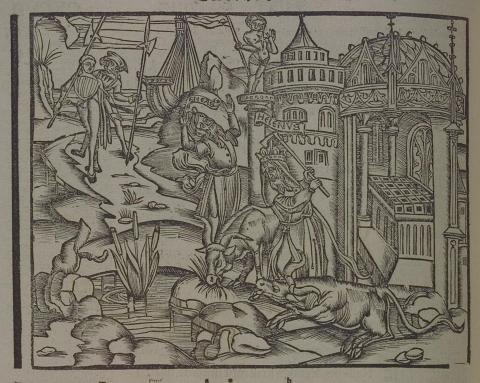Annotations
At Buthrotum, Aeneas addresses both Helenus and an idol of Apollo outside a shrine of Apollo (359-68). Helenus, wearing the clothes of a priest and wearing a fillet - religious headband - on his head, sacrifices two steers (369-73). Afterwards, not depicted, Helenus, in his role as seer, advises the next few steps necessary for Aeneas to successfully continue his journey (374-462). In the background to the left stand two men, likely Aeneas's followers, unidentified. (Katy Purington)
Woodcut illustration from the “Strasbourg Vergil,” edited by Sebastian Brant: Publii Virgilii Maronis Opera cum quinque vulgatis commentariis expolitissimisque figuris atque imaginibus nuper per Sebastianum Brant superadditis (Strasbourg: Johannis Grieninger, 1502), fol. 197v, executed by an anonymous engraver under the direction of Brant.


Sebastian Brant (1458–1521) was a humanist scholar of many competencies. Trained in classics and law at the University of Basel, Brant later lectured in jurisprudence there and practiced law in his native city of Strasbourg. While his satirical poem Das Narrenschiff won him considerable standing as a writer, his role in the transmission of Virgil to the Renaissance was at least as important. In 1502 he and Strasbourg printer Johannes Grüninger produced a major edition of Virgil’s works, along with Donatus’ Life and the commentaries of Servius, Landino, and Calderini, with more than two hundred woodcut illustrations. (Annabel Patterson)